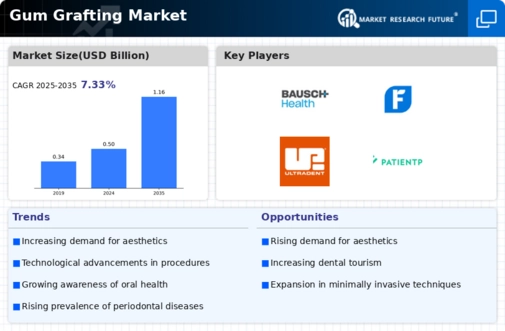Market Trends
Key Emerging Trends in the Gum Grafting Market
Due to increased oral health awareness and gum-related disorders, gum grafting procedures have advanced. These two variables caused these changes. Gum grafting, a surgical therapy for gum recession, has improved in both procedure and material. These breakthroughs changed market dynamics. Driving the industry is the rising incidence of gum recession, which is linked to periodontal disease, forceful teeth cleaning, and hereditary propensity. Due to more people being aware of gum recession's effects, gum grafting operations are in demand. As gum grafting methods have advanced, patients have more treatment options than before. New less invasive procedures, free gingival grafts, and connective tissue grafts have been created. Just a few advances. These modifications improve operation effectiveness and patient happiness. In gum grafting, allografts from human donors and xenografts from animals are being used. Both kinds are autografts. These treatments eliminate the need to remove palate tissue, limiting grafting material options. These methods also address donor tissue shortages. Growth factors and platelet-rich plasma (PRP) are increasingly employed in gum grafting. Bioactive chemicals accelerate tissue regeneration and repair. PRP use has improved in recent years, reducing recovery time and improving results. Aesthetics matter in gum grafting. Increasing numbers of people are interested in surgeries that enhance their smiles' cosmetic appearance and function. Surgeons are using more thorough gum grafting procedures that concentrate on both functional and cosmetic goals. The gum grafting market is still being defined, but the need for less-invasive techniques is pushing it. Patients choose procedures that are less unpleasant, involve less recovery time, and provide outcomes equivalent to conventional grafting. Surgeons increasingly consider patient comfort and ease. The gum grafting industry is being affected by imaging, diagnostics, and surgical equipment improvements. Laser technique for grafting is becoming increasingly popular due to its accuracy and reduced postoperative pain. These technologies may simplify treatment planning with improved imaging. Regenerative medicine principles are being used in gum grafting. Stem cell and tissue engineering have showed promise in overcoming grafting problems. Advances seek to boost tissue regeneration, improve long-term success, and solve procedural issues. The gum grafting industry is growing due to better patient education and awareness. Patients are learning about gum grafting. Dental professionals are aggressively educating patients about gum recession and the different treatment options available. Early intervention improves outcomes. Despite encouraging improvements, gum grafting techniques' high cost might hinder business growth. It is important to address cost issues and investigate insurance coverage possibilities, but it is also important to expand patient access. The worldwide gum grafting market is growing because to greater awareness of dental health and an older population. As dental care becomes more widespread, emerging nations are contributing more to dentistry company development.







Leave a Comment